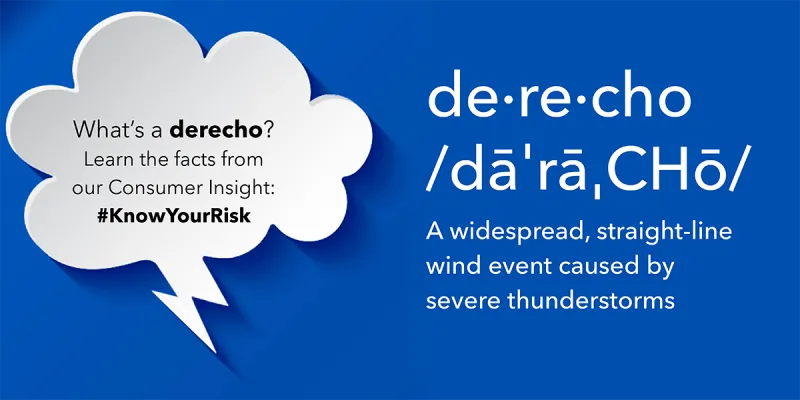
Learn the Facts About Derechos
A derecho (de·re·cho) is a widespread, straight-line wind event caused by severe thunderstorms. Because of how quickly derechos happen and the length of time they last, there is not much time for preparation, making them uniquely dangerous. According to the National Weather Service (NWS), derechos cause more deaths than EF0 and EF1 tornadoes combined.
TOP CONSIDERATIONS
Derechos can be deadly. The speed at which the wind travels means little to no preparation time and is why derechos can be so dangerous. The winds of a derecho travel at least 58 mph and have been recorded as high as 130 mph, according to the NWS.
Damage from derechos happens along a straight path. Derecho means “straight ahead” in Spanish. Unlike tornados, which rotate, derechos move in a straight line and are described as “walls” of wind. Derechos have been known to happen in groups. When a derecho occurs, others may follow in the next few days in different locations.
Derechos are most likely to occur in the Midwest/Central United States. Seventy percent of derechos happen in May, June, July and August. During the remaining 30% of the year, derechos are most likely to occur from eastern Texas into the southeastern states. While it is rare, derechos can also happen in the northeastern and western U.S.
WHAT YOU SHOULD KNOW
Prepare for derechos as you would prepare for a thunderstorm. You can do this by going inside, avoiding landline phones and unplugging electrical appliances. The NWS will issue a severe thunderstorm warning ahead of a derecho.
Outdoor exposure causes higher risks. Remember, there is not much preparation time for derechos. Because of this, people who are outside without access to shelter, like campers and hikers, are at an increased risk.
Almost half of the deaths caused by derechos happen in cars or boats. Boats and cars are likely to be overturned by the high winds.
TOP THREE THINGS TO REMEMBER
-
Derechos move quickly. There is very little time to prepare. The NWS does not issue derecho warnings. The agency will issue a severe thunderstorm warning ahead of a derecho. Check your local weather reports at the beginning of each day, and prepare accordingly. Monitor the forecast throughout the day as the NWS can predict broad areas of severe weather.
-
Derechos can be deadly. While EF0 and EF1 are the most common types of tornados, derechos cause more deaths than those types of tornados combined.
-
Prepare for a derecho the same way you would prepare for a thunderstorm. Go indoors and stay there until the local weather authorities say it is safe to return to normal activities.
About the National Association of Insurance Commissioners
As part of our state-based system of insurance regulation in the United States, the National Association of Insurance Commissioners (NAIC) provides expertise, data, and analysis for insurance commissioners to effectively regulate the industry and protect consumers. The U.S. standard-setting organization is governed by the chief insurance regulators from the 50 states, the District of Columbia and five U.S. territories. Through the NAIC, state insurance regulators establish standards and best practices, conduct peer reviews, and coordinate regulatory oversight. NAIC staff supports these efforts and represents the collective views of state regulators domestically and internationally.
